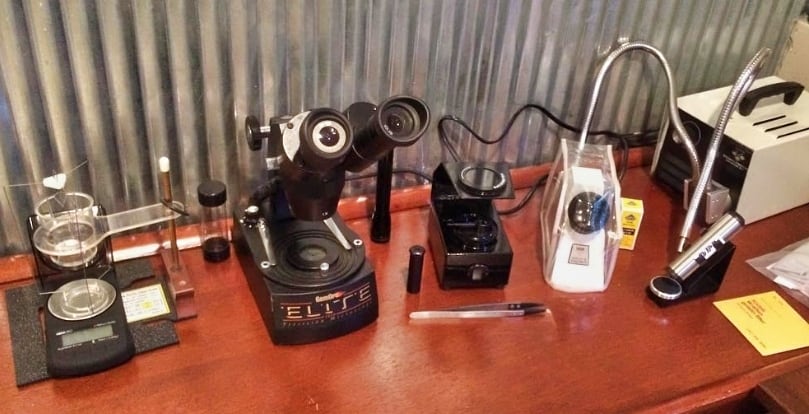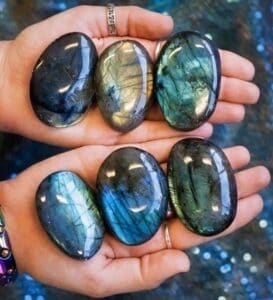Labradorite is incredibly beautiful and often found in basalt, norite, gabbro, anorthosite, and other mafic igneous rocks. Some specimens exhibit a schiller effect which can be seen when you rotate the stone under direct light. This schiller effect is found in Oregon sunstone which is a type of labradorite.
will float around the inside of the stone as you rotate it under the light.
Labradorescence is an effect some labradorite specimens display. When light enters the stone, it strikes a twinning surface inside of the stone and reflects from it. Different twinning surfaces within the labradorite reflect different colors of light. It’s what produces the strong iridescent blue, red, orange, green, and yellow colors.
How to Identify Labradorite Through Testing
There are various ways to identify rocks, minerals, crystals, and gemstones, but we will use a method I learned while attending the Gemological Institute of America. If you’ve learned a unique way to identify gems, then feel free to share it with us.
Let’s take a deeper look into how to identify labradorite like a pro.

Visual Inspection
The visual inspection starts with what form of Labradorite you have. The questions below are relatively easy to answer, but each type will have its own process for identifying them.

Is it a cabochon? A cabochon should have a medium to high polish with little pitting on the surface if you’re dealing with a cabochon. Labradorite has a background color of dark gray but displays rainbow-colored reflection when light hits it in certain spots.
Cabachons are usually intense colors, ranging from blues and violets to yellows, greens, and oranges.
If the labradorite has the schiller effect then it comes from the mines in Oregon. These pieces will display a copper tone and under direct light, you will see a metallic shimmer inside of the stone.
Is it faceted? If you have a faceted piece of Labradorite then it will be a light yellow, orange, red, or green but it depends on where it was mined. Oregon sunstone, aka labradorite, can come in an array of colors and most are faceted or carved.
When viewing the faceted stone under a 10x powered loop you’ll notice they have a high clarity rating but occasionally you’ll see small feathers or fractures that run in the same direction. Labradorite is part of the feldspar family and has a strong cleavage plain.

Is it a specimen? Labradorite is found in different forms. You’ll better identify these forms by looking at and inspecting this mineral over time. Here’s a list of characteristics Labradorite displays when it’s a specimen.
- It can be in various colors with a dark base color.
- Iridescent
- Multicolor internal streaks.
- Labradorescense effect.
- Transparent stones commonly contain elongated black inclusions.
- Fractures are a good thing!
Is it tumbled? Very common to find tumbled labradorite at your local rock and gem show. These pieces will display a glossy shine with dark grey to black streaks running through them. When placed in direct light you’ll notice an iridescence effect that dances around inside the stone as you move it.
Physical Properties of Labradorite
Let’s take a look at the physical properties of labradorite. Knowing what to look for will help you more easily identify what you’re looking at.
Color: Clear, White, Gray, Dark Gray, Black-Gray. Labradorescent Colors: golden yellow, yellow, blue-green, blue, green, orange, red, violets, purple, bronze
Clarity / Transparency: Transparent to Translucent
Luster: Vitreous, Pearly on cleavage faces
Cleavage: Two directions of perfect cleavage
Fracture: Uneven to Conchoidal
The Streak Test
This is a destructive test, so you need to ensure that you’re allowed to damage the specimen or stone if you choose to use this method. Once you’ve developed robust knowledge in identifying rocks and minerals, you won’t be using destructive tests.
A mineral streak test is when you scrape the stone against a harder surface to see what color remains. When dealing with Labradorite, it produces or clear or white streak.
Raw specimens that leave colored streaks can be streaked across a piece of white paper to expose their color.
Tumbled specimens are tested by scraping a specimen across a piece of ungalvanized porcelain, typically known as a streak plate.
Magnet Test
Labradorite is not typically magnetic and shouldn’t respond to common magnets. However, there are exceptions to the magnet test.
For instance, when labradorite contains microscopic particles of magnetite that are dispersed throughout the gray bodies of the gems, it can cause an apparent magnetic response. It’s safe to say that the magnet test isn’t one you should rely heavily on when trying to identify Labradorite.
Hardness Test
I don’t recommend actively testing the hardness of a stone because it’s destructive in nature and doesn’t really provide a definite answer to what type of stone it is. With that being said, Labradorite has a hardness of 6 to 6.5 on the Mohs hardness scale.
Refractive Index Test
Determining the refractive index, or RI as it’s referred to by gemologists, for labradorite is relatively straightforward, but you’ll need a specific piece of test equipment and the RI fluid to go with it. Before you place the stone on the refractometer, you want to make sure you have a flat, somewhat polished surface to take a reading.
Labradorite’s Refractive Index: 1.554 – 1.573
Each gemstone has its own RI, so discovering a sample’s RI can help you figure out what sort of stone it actually is.
Step 1 – Place a small bead of RI fluid on the metal surface of the refractometer near the back of the crystal hemicylinder (the window on which the stone will sit).
Step 2 – Place the stone facet face down on the fluid dot and slide it toward the middle of the hemicylinder crystal using your fingers.
Step 3 – Look through the viewer lens without magnification. Continue looking until you see the outline of a bubble, then look at the bottom of this bubble. Take the reading from there, rounding the decimal to the nearest hundredth.
From time to time, you’ll run into the issue of not having a flat surface to work with. In this instance, you’ll need to leave the top of the refractometer open and hold the rounded stone with your hand. Hopefully, you’ll be able to pull a reading off of the gauge.
Birefringence Test
Consider testing the birefringence, as well. Birefringence is related to RI. While doing the birefringence test, you will turn the gemstone on the refractometer six times throughout the observation period and note the changes.
Perform a standard RI test. Instead of keeping the stone still, gradually turn it 180 degrees, making each separate turn about 30 degrees. At each 30-degree mark, take a new RI reading.
Subtract the lowest reading from the highest to find the stone’s birefringence. Round it to the nearest thousandth.
Birefringence: δ = 0.007 – 0.011
Single or Double Refraction
Labradorite is doubly refractive!
For this test to be accurate and beneficial, the stone must be transparent. If the light won’t pass through the stone, then there is no way to test for single or double refraction.
Check for single or double refraction. Use this test on translucent and transparent stones. You can determine whether the stone is only singly refractive (SR) or doubly refractive (DR) to help identify it. Some stones can also be classified as aggregate (AGG).
Turn on the light of a polariscope and place the stone face down on the lower glass lens (polarizer). Look through the top lens (analyzer), turning the top lens until the area around the stone looks darkest. This is your starting point.
Turn the analyzer 360 degrees and watch how the light around the stone changes.
If the stone appears dark and stays dark, it is likely an SR. If the stone starts light and remains light, it is likely AGG. If the lightness or darkness of the stone changes, it is likely DR.
Checking The Diaphaneity
Diaphaneity refers to the mineral’s ability to transmit light. For instance, some minerals are transparent or translucent. A small amount of distortion might occur when they’re thick, but light will pass through them relatively freely.
Labradorite can be transparent to translucent. However, its translucency depends on the form it has taken. If the Labradorite has a cloudy or earthy form, there won’t be as much light traveling through it. However, when Labradorite is exposed to bright light and looked at from different angles, you can see flashes of yellow, blue, violet, orange, and green.
Finding The Specific Gravity
Every stone has its unique specific gravity, which helps us identify them. Specific gravity is one of the best properties to measure when identifying mineral specimens. Most minerals have a narrow range of specific gravity, so getting an accurate measurement can go a long way toward identification.
Specific gravity is a unitless number describing how heavy a mineral is compared to equal volumes of water. For example, if a mineral is three times as dense as water, it’ll have a specific gravity of three. This is useful because while two minerals might be the same size, they’ll each have a different specific gravity.
The larger the sample, the more precise the readings tend to be. Remember that this technique can only be used for single mineral or crystal masses. It will not work for minerals embedded in host rocks.
Labradorite’s Specific Gravity: 2.69 – 2.72
As helpful as specific gravity is for identifying minerals, amateurs are usually constrained by the lack of necessary tools for the job. However, one way to work around this is to hold the specimen and note how heavy or heft it feels compared to what you might expect a specimen of that size to weigh.
If you want to determine the specific gravity of your stone like a pro, you’ll need to invest in a higher-end scale. This is the one gemologists use OHAUS Density Determination Kit.
Identifying Rocks and Minerals Like a Pro
Hopefully, you feel confident in your practice of identifying a piece of labradorite after reading and applying this guide. You’ll be using the visual part of this guide the most, and you’ll get better as you interact with more gemstones. Before you know it, you’ll be identifying stones like a gemologist.
Feel free to reach out if you run into any issues or need clarification. I’ll do my best to assist you in the identification process.
- Identify Enstatite - March 12, 2024
- Identify Cerussite - March 3, 2024
- Identify Bytownite - February 18, 2024
